
Question relating to electric guitar pickups and capacitance .
Ash Small, Fri Feb 05 2016, 01:07AMI've been puzzling over this one for ages now
Suppose you have a typical single coil electric guitar pickup, no humbucker or anything just a simple single coil pickup, as used by Fender, for example
Now, suppose you wind it for, say, 10 Henries, using AWG 43 wire, but tap it at every Henry, so you end up with a multi - tapped pickup wired to a ten way switch, for example, so you can change the inductance of the pickup just by turning a knob .
What I want to know is, supposing the switch is set to one Henry inductance, does the capacitance of the unused windings contribute to the capacitance of the coil, or do I only need to consider the capacitance of the windings currently switched into the circuit?
Re: Question relating to electric guitar pickups and capacitance .
DerAlbi, Fri Feb 05 2016, 03:42AM
First thing crossing my mind: "a tap every Henry". How would you do it?
Lets say youve got an AL-value of 10mH. So you need 10 turns for 1H. For 2H you need only 14 turns. So your Taps would be: 10 turns, 14 turns, 17 turns and so on. Strange: the coil fomred between turn 10 and turn 4 can only have 160mH.
Somehow the model of the coupled inductor is in the way here.
But answering your question concerning the parasitics: it depends on the coupling.
If the coupling is bad, then the parasitic capacitance decreases, because the turn-2-turn capacitance wont do much of the unused turns. You are basically left with a piece of wire thats acting as capacitance against earth - might be bad on its own.. but...
If the coupling is strong, then you wont gain much. The parasitic capacitance is a load to the "transformer" which is reflected to the soruce according to the winding-ratio. So using only half the turns still gives you the full parasitic capacitance.
DerAlbi, Fri Feb 05 2016, 03:42AM
First thing crossing my mind: "a tap every Henry". How would you do it?
Lets say youve got an AL-value of 10mH. So you need 10 turns for 1H. For 2H you need only 14 turns. So your Taps would be: 10 turns, 14 turns, 17 turns and so on. Strange: the coil fomred between turn 10 and turn 4 can only have 160mH.
Somehow the model of the coupled inductor is in the way here.
But answering your question concerning the parasitics: it depends on the coupling.
If the coupling is bad, then the parasitic capacitance decreases, because the turn-2-turn capacitance wont do much of the unused turns. You are basically left with a piece of wire thats acting as capacitance against earth - might be bad on its own.. but...
If the coupling is strong, then you wont gain much. The parasitic capacitance is a load to the "transformer" which is reflected to the soruce according to the winding-ratio. So using only half the turns still gives you the full parasitic capacitance.
Re: Question relating to electric guitar pickups and capacitance .
Ash Small, Fri Feb 05 2016, 04:08AM
Thanks for the reply Der Albi, I thought the answer might be along the lines of 'neither one or the other' , I'm just going to have to build a test rig and make some measurements.
Off the top of my head, without checking references, I think these type of pickups require in the region of 6-8 thousand turns for a few Henries, although, as we all know, there is more to it than just the number of turns.
Fender's own pickups can vary from less than two Henries on some more modern pickups to nearly ten on some of the early ones from 65 years ago.
Ash Small, Fri Feb 05 2016, 04:08AM
Thanks for the reply Der Albi, I thought the answer might be along the lines of 'neither one or the other' , I'm just going to have to build a test rig and make some measurements.
Off the top of my head, without checking references, I think these type of pickups require in the region of 6-8 thousand turns for a few Henries, although, as we all know, there is more to it than just the number of turns.
Fender's own pickups can vary from less than two Henries on some more modern pickups to nearly ten on some of the early ones from 65 years ago.
Re: Question relating to electric guitar pickups and capacitance .
radiotech, Fri Feb 05 2016, 10:09AM
What kind of switch could you design to open and close such a small potential with no
wiping potential, and to work reliably after having been bounced all over the land by a
traveling musician .
Design the switch, to engage multiple windings in series parallel, so each step uses ALL the copper.
At the amplifier end, do the same with an input transformer.
What will happen, is the project will produce a 'voicing' switch.
Subtle as it is, if the coil draws power from the strings, it damps them.
Here is a scheme for maximum copper usage of a winding, from long ago.
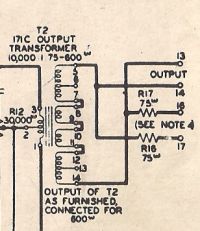
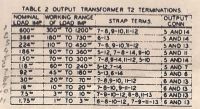
radiotech, Fri Feb 05 2016, 10:09AM
What kind of switch could you design to open and close such a small potential with no
wiping potential, and to work reliably after having been bounced all over the land by a
traveling musician .
Design the switch, to engage multiple windings in series parallel, so each step uses ALL the copper.
At the amplifier end, do the same with an input transformer.
What will happen, is the project will produce a 'voicing' switch.
Subtle as it is, if the coil draws power from the strings, it damps them.
Here is a scheme for maximum copper usage of a winding, from long ago.


Re: Question relating to electric guitar pickups and capacitance .
Ash Small, Fri Feb 05 2016, 11:52AM
You've some excellent ideas there RT. I did read somewhere that putting a capacitor in parallel with the switch, and maybe a resistor too, would eliminate such problems.
This isn't a new idea, you can already buy something similar. I'm just considering combining it with some other ideas I have.
Apparently the lead from the guitar to the amplifier can have significant capacitance. Would it be better to put the impedance matching network on the guitar side of the lead ?
EDIT: String pull is a fascinating subject in itself
Ash Small, Fri Feb 05 2016, 11:52AM
You've some excellent ideas there RT. I did read somewhere that putting a capacitor in parallel with the switch, and maybe a resistor too, would eliminate such problems.
This isn't a new idea, you can already buy something similar. I'm just considering combining it with some other ideas I have.
Apparently the lead from the guitar to the amplifier can have significant capacitance. Would it be better to put the impedance matching network on the guitar side of the lead ?
EDIT: String pull is a fascinating subject in itself

Re: Question relating to electric guitar pickups and capacitance .
radiotech, Fri Feb 05 2016, 07:12PM
The best solution is to incorporate a preamp into the pickup and phantom-power it
from the amplifier, or from the studio mixer itself. Then lead capacitance vanishes
and the signal can 30dB higher.
See
radiotech, Fri Feb 05 2016, 07:12PM
The best solution is to incorporate a preamp into the pickup and phantom-power it
from the amplifier, or from the studio mixer itself. Then lead capacitance vanishes
and the signal can 30dB higher.
See

Re: Question relating to electric guitar pickups and capacitance .
Ash Small, Fri Feb 05 2016, 08:16PM
I don't really want to use active pickups if possible, but I do now have an idea involving a rewound vintage interstage transformer with multiple switchable primaries
Ash Small, Fri Feb 05 2016, 08:16PM
I don't really want to use active pickups if possible, but I do now have an idea involving a rewound vintage interstage transformer with multiple switchable primaries

Re: Question relating to electric guitar pickups and capacitance .
Signification, Sat Feb 06 2016, 05:44AM
I am not familiar with such "pickup coils" at all. But what would happen if you shorted out all the unused windings via the taps above the desired inductance? For example, if you want 4H, short "ALL" the other taps--not just 4-10, but 4-5, 5-6, 6-7, 7-8, 8-9, 9-10?
Or a switch that connects tap 4 to the circuit and completely isolates the rest of the coil at tap 5, leaving the remaining 6H coil floating and/or shorted?
Signification, Sat Feb 06 2016, 05:44AM
I am not familiar with such "pickup coils" at all. But what would happen if you shorted out all the unused windings via the taps above the desired inductance? For example, if you want 4H, short "ALL" the other taps--not just 4-10, but 4-5, 5-6, 6-7, 7-8, 8-9, 9-10?
Or a switch that connects tap 4 to the circuit and completely isolates the rest of the coil at tap 5, leaving the remaining 6H coil floating and/or shorted?
Re: Question relating to electric guitar pickups and capacitance .
Sigurthr, Sat Feb 06 2016, 06:49AM
Those shorted sections just appear as shorts, loading down the output signal. It's the same as if you had a power transformer and shorted all the windings you didn't use.
@Ash what significance does stray capacitance have on the guitar signal anyway? It's all AF range, so aside from maybe some weird resonances all you'd see are phase changes right? If your amp is voltage driven (or specifically, if the amp's preamp is) what significance does phase changes have on the output.
I like the idea of multiple varied impedance taps, it would be interesting to hear the differences in sound. But I wonder what would happen if you were to include two variable capacitors and a bypass switch into the build? One varicap in parallel, one in series, with the series one able to be bypassed (shorted) with the switch. You should be able to play around with capacitance then to see if there is any noticeable changes in sound. You wouldn't even need to incorporate them into the guitar body, just make an effect box out of them. I can see the series capacitance would need to be hefty in order to not cause a severe high pass effect, but the parallel capacitance could be on the order of what your suspected inter-winding capacitance is, and that wouldn't be large at all.
Sigurthr, Sat Feb 06 2016, 06:49AM
Those shorted sections just appear as shorts, loading down the output signal. It's the same as if you had a power transformer and shorted all the windings you didn't use.
@Ash what significance does stray capacitance have on the guitar signal anyway? It's all AF range, so aside from maybe some weird resonances all you'd see are phase changes right? If your amp is voltage driven (or specifically, if the amp's preamp is) what significance does phase changes have on the output.
I like the idea of multiple varied impedance taps, it would be interesting to hear the differences in sound. But I wonder what would happen if you were to include two variable capacitors and a bypass switch into the build? One varicap in parallel, one in series, with the series one able to be bypassed (shorted) with the switch. You should be able to play around with capacitance then to see if there is any noticeable changes in sound. You wouldn't even need to incorporate them into the guitar body, just make an effect box out of them. I can see the series capacitance would need to be hefty in order to not cause a severe high pass effect, but the parallel capacitance could be on the order of what your suspected inter-winding capacitance is, and that wouldn't be large at all.
Re: Question relating to electric guitar pickups and capacitance .
Ash Small, Sat Feb 06 2016, 02:43PM
Sigurther, it's pretty much exactly what you describe as 'wierd resonances'. That's basically all that differentiates the tone or sound of one guitar compared to another.
The tone circuit on an electric guitar uses capacators pretty much the way you describe.
Any LCR circuit will resonate at some frequencies, and tend to block others.
Any guitar pickup has a resonant peak, frequencies around this resonant peak are enhanced, while frequencies above this tend to be blocked. Frequencies below this point just sound like you would expect them to.
I'm trying to keep this as simple as possible.
Stray capacitance or added capacitors will lower the resonant peak.
Ash Small, Sat Feb 06 2016, 02:43PM
Sigurther, it's pretty much exactly what you describe as 'wierd resonances'. That's basically all that differentiates the tone or sound of one guitar compared to another.
The tone circuit on an electric guitar uses capacators pretty much the way you describe.
Any LCR circuit will resonate at some frequencies, and tend to block others.
Any guitar pickup has a resonant peak, frequencies around this resonant peak are enhanced, while frequencies above this tend to be blocked. Frequencies below this point just sound like you would expect them to.
I'm trying to keep this as simple as possible.
Stray capacitance or added capacitors will lower the resonant peak.
Re: Question relating to electric guitar pickups and capacitance .
Sigurthr, Sun Feb 07 2016, 03:32AM
Interesting! I didn't think the Q was high enough to hear audible changes from the interwinding capacitances. I assumed the per-guitar tonal differences were mostly from geometric differences and material density/hardness differences in the body, and would massively overpower any electrically induced resonances.
It makes sense that the tone circuit is a low pass filter.
Regarding your original question then, it would sound as if the unused taps if left open, would not have contributing capacitances, as parasitic interwinding capacitance is in parallel with the inductor, and if the lead of the inductor is left open then the distributed capacitance in those open windings is also left open.
Sigurthr, Sun Feb 07 2016, 03:32AM
Interesting! I didn't think the Q was high enough to hear audible changes from the interwinding capacitances. I assumed the per-guitar tonal differences were mostly from geometric differences and material density/hardness differences in the body, and would massively overpower any electrically induced resonances.
It makes sense that the tone circuit is a low pass filter.
Regarding your original question then, it would sound as if the unused taps if left open, would not have contributing capacitances, as parasitic interwinding capacitance is in parallel with the inductor, and if the lead of the inductor is left open then the distributed capacitance in those open windings is also left open.
Re: Question relating to electric guitar pickups and capacitance .
Signification, Sun Feb 07 2016, 04:38AM
WRT all of the facts brought up here, inductance, 43AWG wire resistance "Q", etc. this brings back a memory of a high inductance coil experiment done at MIT that demonstrates the slow rise in current through a 30H @ 4 Ohm inductor (7.5s TC) in showing how long it takes a 2 Ohm incandescent lamp in series with a 2 ohm resister to reach full brightness. the delay was impressive!
------
Question: How do you make a 30H inductor (I don't recall if it was adjustable) with only 4 Ohm ESR?
The instructor commented to tell how later, but I never ran across it--been bothering me ever since!!!
Signification, Sun Feb 07 2016, 04:38AM
WRT all of the facts brought up here, inductance, 43AWG wire resistance "Q", etc. this brings back a memory of a high inductance coil experiment done at MIT that demonstrates the slow rise in current through a 30H @ 4 Ohm inductor (7.5s TC) in showing how long it takes a 2 Ohm incandescent lamp in series with a 2 ohm resister to reach full brightness. the delay was impressive!
------
Question: How do you make a 30H inductor (I don't recall if it was adjustable) with only 4 Ohm ESR?
The instructor commented to tell how later, but I never ran across it--been bothering me ever since!!!
Re: Question relating to electric guitar pickups and capacitance .
Sigurthr, Sun Feb 07 2016, 09:41AM
30H with 4R ESR? Planar (strips of) copper.
Sigurthr, Sun Feb 07 2016, 09:41AM
30H with 4R ESR? Planar (strips of) copper.
Re: Question relating to electric guitar pickups and capacitance .
Ash Small, Sun Feb 07 2016, 12:37PM
Sigurther, the wood/neck/body of the guitar can also affect the tone. There are a lot of factors to consider.
I'm interested in the pickups in this thread, though. Early guitar pickups were derived from steel guitar pickups which had inductances in the region of 10H, while it's quite common for modern pickups to have an inductance in the region of 2-3H.
Pickup manufacturers don't tend to quote the inductance though, generally. They tend to quote DC resistance, which they refer to as impedance.
Early electric guitars also tended to use weaker magnets, alnico 2 or 3, where as modern pickups tend to use alnico 5.
The obvious thing a lot of people say is 'why not use neo's?'....which have ten times the magnetism of alnico 5.
It has been tried, but as was pointed out above, stronger magnets cause more 'string pull' which damps the strings and kills sustain.
The deeper you get into it, the more interesting it gets.
EDIT: Stray capacitance plays a big part too, early pickups tended to be hand wound, with looser turns. These tended to have less capacitance than tightly wound ones wound by machine. Early pickups tended to use wire wirh Formvar insulation, which was thicker than enamel, with a lower dielectric constant, again leading to less capacitance.
Over the past 65 years pickups haven't necessarily become better, but they have become cheaper to produce
Ash Small, Sun Feb 07 2016, 12:37PM
Sigurther, the wood/neck/body of the guitar can also affect the tone. There are a lot of factors to consider.
I'm interested in the pickups in this thread, though. Early guitar pickups were derived from steel guitar pickups which had inductances in the region of 10H, while it's quite common for modern pickups to have an inductance in the region of 2-3H.
Pickup manufacturers don't tend to quote the inductance though, generally. They tend to quote DC resistance, which they refer to as impedance.
Early electric guitars also tended to use weaker magnets, alnico 2 or 3, where as modern pickups tend to use alnico 5.
The obvious thing a lot of people say is 'why not use neo's?'....which have ten times the magnetism of alnico 5.
It has been tried, but as was pointed out above, stronger magnets cause more 'string pull' which damps the strings and kills sustain.
The deeper you get into it, the more interesting it gets.

EDIT: Stray capacitance plays a big part too, early pickups tended to be hand wound, with looser turns. These tended to have less capacitance than tightly wound ones wound by machine. Early pickups tended to use wire wirh Formvar insulation, which was thicker than enamel, with a lower dielectric constant, again leading to less capacitance.
Over the past 65 years pickups haven't necessarily become better, but they have become cheaper to produce

Re: Question relating to electric guitar pickups and capacitance .
radiotech, Thu Feb 11 2016, 11:32AM
Pickup manufacturers don't tend to quote the inductance though, generally. They tend to quote DC resistance, which they refer to as impedance.
Inductance of an iron core coil needs agreement on how it is to be measured.
radiotech, Thu Feb 11 2016, 11:32AM
Pickup manufacturers don't tend to quote the inductance though, generally. They tend to quote DC resistance, which they refer to as impedance.
Inductance of an iron core coil needs agreement on how it is to be measured.
Re: Question relating to electric guitar pickups and capacitance .
Ash Small, Fri Feb 26 2016, 02:23AM
Well, I bought a cheap kit on eBay and personalised it a bit, but this is the 'test rig' for my pickup ideas.
It came with a neck pickup as well, but I just want the one bridge pickup for evaluation purposes. The brushed stainless pickguard is to cover the hole for the neck pickup. The control plate cover is to cover the hole where the volume and tone pots, and three way switch normally go.
I figure I can add filters, etc. outside the guitar for evaluation purposes, before considering building them into the guitar itself. My amps all have volume controls
For those who are familiar with the history of solid bodied electric guitars, it's of the Fender Telecaster family, but, due to the single bridge pickup, and the fact that at the moment it has a truss rod in the neck, it resembles an Esquire rather than a single pickup Broadcaster.
For those of you who still have no idea about different electric guitars, it resembles the guitar used on the early Johnny Cash records, played by Luther Perkins.
It is 'hotwired' straight from the bridge pickup to the output jack. I plan to add external filters, etc. as required.
I built it as a 'test bed' for pickups, etc.
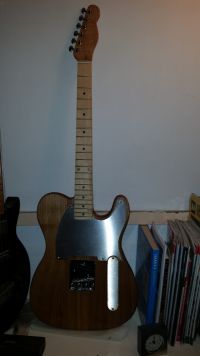
EDIT: No strings on it yet, by the way.The strings that came with the kit aren't what I want to use, but I may fit them while I'm waiting to order some others.
Ash Small, Fri Feb 26 2016, 02:23AM
Well, I bought a cheap kit on eBay and personalised it a bit, but this is the 'test rig' for my pickup ideas.
It came with a neck pickup as well, but I just want the one bridge pickup for evaluation purposes. The brushed stainless pickguard is to cover the hole for the neck pickup. The control plate cover is to cover the hole where the volume and tone pots, and three way switch normally go.
I figure I can add filters, etc. outside the guitar for evaluation purposes, before considering building them into the guitar itself. My amps all have volume controls

For those who are familiar with the history of solid bodied electric guitars, it's of the Fender Telecaster family, but, due to the single bridge pickup, and the fact that at the moment it has a truss rod in the neck, it resembles an Esquire rather than a single pickup Broadcaster.
For those of you who still have no idea about different electric guitars, it resembles the guitar used on the early Johnny Cash records, played by Luther Perkins.
It is 'hotwired' straight from the bridge pickup to the output jack. I plan to add external filters, etc. as required.
I built it as a 'test bed' for pickups, etc.

EDIT: No strings on it yet, by the way.The strings that came with the kit aren't what I want to use, but I may fit them while I'm waiting to order some others.
Re: Question relating to electric guitar pickups and capacitance .
Ash Small, Wed Mar 16 2016, 01:56AM
I'm still playing around with this, getting it set up as best I can with the bridge pickup that came with the kit.
I've added some brushed stainless steel to it, though.
Just working on a 'box of tricks' to plug it into, I've modified some three pole, four way rotary sawitches to single pole, 12 way, and I'm just finalising details of values of series/pararallel capacitors and resistors, for various combinations on passive filters, and re-thinking the whole pickup inductance thing.
I'm just playing it through an early solid state, Yamaha built Marshall clone. It's starting to sound quite good, I just need to learn to play
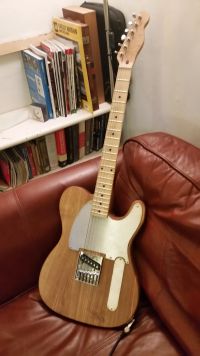
The idea behind this is to learn something about inductance.
Just bought these, building a cabinet for them at the moment, there are various online guides, but the Celestion handbook thing is the one I'm using mostly.
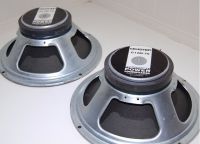
Link to the amp I'm building here:
Ash Small, Wed Mar 16 2016, 01:56AM
I'm still playing around with this, getting it set up as best I can with the bridge pickup that came with the kit.
I've added some brushed stainless steel to it, though.
Just working on a 'box of tricks' to plug it into, I've modified some three pole, four way rotary sawitches to single pole, 12 way, and I'm just finalising details of values of series/pararallel capacitors and resistors, for various combinations on passive filters, and re-thinking the whole pickup inductance thing.
I'm just playing it through an early solid state, Yamaha built Marshall clone. It's starting to sound quite good, I just need to learn to play


The idea behind this is to learn something about inductance.
Just bought these, building a cabinet for them at the moment, there are various online guides, but the Celestion handbook thing is the one I'm using mostly.

Link to the amp I'm building here:

Re: Question relating to electric guitar pickups and capacitance .
radiotech, Fri Mar 18 2016, 07:47PM
The output transformer has no DC current in primary. Does the plate choke maintain the inductance with the
DC current through it ? C3 seems to a standard polarized capacitor which may somewhat rectify the current and change
the sound from that had with a non polarized type.
Most output transformers are designed to perform with a DC component because of the gap.
radiotech, Fri Mar 18 2016, 07:47PM
The output transformer has no DC current in primary. Does the plate choke maintain the inductance with the
DC current through it ? C3 seems to a standard polarized capacitor which may somewhat rectify the current and change
the sound from that had with a non polarized type.
Most output transformers are designed to perform with a DC component because of the gap.
Re: Question relating to electric guitar pickups and capacitance .
BigBad, Sat Mar 19 2016, 12:40AM
LOL, short answer: no.
Long answer: yes, the extra taps have capacitance that could make a difference even if they're not carrying current because they're repeatedly raised and lowered in voltage, but no it makes no difference, because that capacitance is minute. You'd only have to worry about the extra capacitance if the pickup was running at its self resonant frequency, which likely to be in the megahertz range; and enormously beyond the audible range, and is unlikely to be driven by anything.
If the pickup is not running at that frequency, then the extra few tens of picofarads is irrelevant.
BigBad, Sat Mar 19 2016, 12:40AM
Ash Small wrote ...
Sigurther, it's pretty much exactly what you describe as 'wierd resonances'. That's basically all that differentiates the tone or sound of one guitar compared to another.
...
Any LCR circuit will resonate at some frequencies, and tend to block others.
Any guitar pickup has a resonant peak, frequencies around this resonant peak are enhanced, while frequencies above this tend to be blocked. Frequencies below this point just sound like you would expect them to.
...
Stray capacitance or added capacitors will lower the resonant peak.
Sigurther, it's pretty much exactly what you describe as 'wierd resonances'. That's basically all that differentiates the tone or sound of one guitar compared to another.
...
Any LCR circuit will resonate at some frequencies, and tend to block others.
Any guitar pickup has a resonant peak, frequencies around this resonant peak are enhanced, while frequencies above this tend to be blocked. Frequencies below this point just sound like you would expect them to.
...
Stray capacitance or added capacitors will lower the resonant peak.
LOL, short answer: no.
Long answer: yes, the extra taps have capacitance that could make a difference even if they're not carrying current because they're repeatedly raised and lowered in voltage, but no it makes no difference, because that capacitance is minute. You'd only have to worry about the extra capacitance if the pickup was running at its self resonant frequency, which likely to be in the megahertz range; and enormously beyond the audible range, and is unlikely to be driven by anything.
If the pickup is not running at that frequency, then the extra few tens of picofarads is irrelevant.
Re: Question relating to electric guitar pickups and capacitance .
hen918, Sat Mar 19 2016, 09:56AM
10H 20pF
1/(2π√(10*20*10^-12))ÂÂÂ=11254Hz
That's Audible.
hen918, Sat Mar 19 2016, 09:56AM
BigBad wrote ...
...
... You'd only have to worry about the extra capacitance if the pickup was running at its self resonant frequency, which likely to be in the megahertz range; and enormously beyond the audible range, and is unlikely to be driven by anything.
If the pickup is not running at that frequency, then the extra few tens of picofarads is irrelevant.
...
... You'd only have to worry about the extra capacitance if the pickup was running at its self resonant frequency, which likely to be in the megahertz range; and enormously beyond the audible range, and is unlikely to be driven by anything.
If the pickup is not running at that frequency, then the extra few tens of picofarads is irrelevant.
10H 20pF
1/(2π√(10*20*10^-12))ÂÂÂ=11254Hz
That's Audible.
Re: Question relating to electric guitar pickups and capacitance .
BigBad, Sun Mar 20 2016, 03:02PM
If that's the only capacitive loading, sure. If there's other capacitance, then the resonant frequency will be somewhere else.
And even then, it depends whether it's being driven by anything, and you'd have to calculate the q-factor to find out whether it's a problem.
BigBad, Sun Mar 20 2016, 03:02PM
If that's the only capacitive loading, sure. If there's other capacitance, then the resonant frequency will be somewhere else.
And even then, it depends whether it's being driven by anything, and you'd have to calculate the q-factor to find out whether it's a problem.
Re: Question relating to electric guitar pickups and capacitance .
Ash Small, Tue Mar 22 2016, 08:14PM
Apparently the choke won't have a problem maintaining inductance. I'm using two Varley 20H @120mA chokes, and I'll be running them at a lot less than 120mA.
C3 is actually a motor run capacitor (or similar), non polarised and at least 400V. I'll probably use 630V, if I have any, or I could series a couple of 20uF 400V ones.
One of the beautys of this circuit is that you don't need a gapped O/T, you can use one from a push-pull type amp, which are a lot more common. C3 'should' provide overcurrent protection for the OT primary too, in case of a 'mishap'. I've read about a lot of 'fried' O/T's recently
Here's a graph depicting the response from a 'similar' pickup to the one presently in the guitar. It shows resonant frequencies with various value parallel capacitors, and the turquoise line is with no additional capacitance, just the pickup's response curve. The resonant peak is between 5kh and 6kH.

I guess Hen is 'in the ballpark', the inductance of the pickup used will be less than 10H, I imagine, so it has considerably more than 20pF capacitance
Ash Small, Tue Mar 22 2016, 08:14PM
radiotech wrote ...
The output transformer has no DC current in primary. Does the plate choke maintain the inductance with the
DC current through it ? C3 seems to a standard polarized capacitor which may somewhat rectify the current and change
the sound from that had with a non polarized type.
Most output transformers are designed to perform with a DC component because of the gap.
The output transformer has no DC current in primary. Does the plate choke maintain the inductance with the
DC current through it ? C3 seems to a standard polarized capacitor which may somewhat rectify the current and change
the sound from that had with a non polarized type.
Most output transformers are designed to perform with a DC component because of the gap.
Apparently the choke won't have a problem maintaining inductance. I'm using two Varley 20H @120mA chokes, and I'll be running them at a lot less than 120mA.
C3 is actually a motor run capacitor (or similar), non polarised and at least 400V. I'll probably use 630V, if I have any, or I could series a couple of 20uF 400V ones.
One of the beautys of this circuit is that you don't need a gapped O/T, you can use one from a push-pull type amp, which are a lot more common. C3 'should' provide overcurrent protection for the OT primary too, in case of a 'mishap'. I've read about a lot of 'fried' O/T's recently

BigBad wrote ...
Long answer: yes, the extra taps have capacitance that could make a difference even if they're not carrying current because they're repeatedly raised and lowered in voltage, but no it makes no difference, because that capacitance is minute. You'd only have to worry about the extra capacitance if the pickup was running at its self resonant frequency, which likely to be in the megahertz range; and enormously beyond the audible range, and is unlikely to be driven by anything.
If the pickup is not running at that frequency, then the extra few tens of picofarads is irrelevant.
Long answer: yes, the extra taps have capacitance that could make a difference even if they're not carrying current because they're repeatedly raised and lowered in voltage, but no it makes no difference, because that capacitance is minute. You'd only have to worry about the extra capacitance if the pickup was running at its self resonant frequency, which likely to be in the megahertz range; and enormously beyond the audible range, and is unlikely to be driven by anything.
If the pickup is not running at that frequency, then the extra few tens of picofarads is irrelevant.
Here's a graph depicting the response from a 'similar' pickup to the one presently in the guitar. It shows resonant frequencies with various value parallel capacitors, and the turquoise line is with no additional capacitance, just the pickup's response curve. The resonant peak is between 5kh and 6kH.

hen918 wrote ...
10H 20pF
1/(2π√(10*20*10^-12))ÂÂÂ=11254Hz
That's Audible.
10H 20pF
1/(2π√(10*20*10^-12))ÂÂÂ=11254Hz
That's Audible.
I guess Hen is 'in the ballpark', the inductance of the pickup used will be less than 10H, I imagine, so it has considerably more than 20pF capacitance

Re: Question relating to electric guitar pickups and capacitance .
Ash Small, Fri Dec 09 2016, 12:01AM
Well, despite two bouts of pneumonia since I last posted any progress here, and loads of other stuff needing doing over the summer, and getting side tracked making jigs and templates to produce guitar bridges in batches, because of all the interest shown elsewhere on the internet where I've been researching this subject, I've now made some considerable progress with the 'test bed' that I intend to use for pickups.
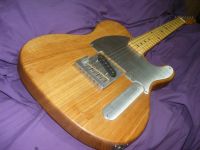
Ash Small, Fri Dec 09 2016, 12:01AM
Well, despite two bouts of pneumonia since I last posted any progress here, and loads of other stuff needing doing over the summer, and getting side tracked making jigs and templates to produce guitar bridges in batches, because of all the interest shown elsewhere on the internet where I've been researching this subject, I've now made some considerable progress with the 'test bed' that I intend to use for pickups.

Print this page